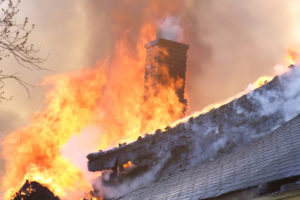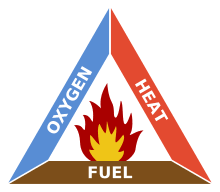



To safely enjoy using your open fire, woodburning stove or gas fire during the winter months your flue has to be well looked after. A well-maintained flue will greatly reduce the risk of a chimney fire.
 A chimney fire is both dangerous and frightening. The temperature inside a flue can very quickly reach up to 1,100°c. as deposits in the flue or chimney catch light due to high temperatures or flames extending from a fire or appliance.
A chimney fire is both dangerous and frightening. The temperature inside a flue can very quickly reach up to 1,100°c. as deposits in the flue or chimney catch light due to high temperatures or flames extending from a fire or appliance.
A chimney fire can take hold very quickly and present an even greater risk to properties with wooden or thatched roofs. Sparks can spread from the top of the chimney or through cracks in the flue and ignite the roof, roof timbers or other parts of the property. Adjacent properties and any nearby trees are also at risk.
The signs to look out for if you suspect that your chimney or flue might be on fire are:
Having noted the signs to look out for, it must be said that chimney fires can also happen without being obvious at all. The unnoticed chimney fire can still cause substantial amounts of damage though.
If you think that you may have had a fire in your chimney or flue, it is important to get it inspected by an experienced chimney professional before using it again.
There are many things that can increase the risk of a chimney fire –
Even if you can’t see any damage, it is highly likely that damage will have occurred inside the chimney or flue following a chimney fire. A chimney fire can burn hot enough to crack the walls of a chimney and can cause damage to any type of flue liner as well as to chimney pots and cowls.
Of all the risks outlined above trying to keep your woodburning stove running overnight by smouldering wood at a low temperature is the most damaging to your flue and runs a great risk of causing a chimney fire.
 Remember the fire triangle at school? The critical elements for combustion are oxygen, heat and fuel. If you reduce the oxygen supply and the heat in your woodburning stove, not everything will be burnt as a result. The unburnt, combustible material – such as tar, creosote and paraffin will pass into the flue and then stick to the liner and ignite at a later date. This will happen irrespective of how well seasoned your wood is. Additionally, tar that sticks to the side of the flue is impossible to remove – it has similar properties to tar that is used for surfacing roads.
Remember the fire triangle at school? The critical elements for combustion are oxygen, heat and fuel. If you reduce the oxygen supply and the heat in your woodburning stove, not everything will be burnt as a result. The unburnt, combustible material – such as tar, creosote and paraffin will pass into the flue and then stick to the liner and ignite at a later date. This will happen irrespective of how well seasoned your wood is. Additionally, tar that sticks to the side of the flue is impossible to remove – it has similar properties to tar that is used for surfacing roads.
Always read the stove manufacturers guide for use carefully. Also, bear in mind that a manufacturer may state that it is possible to run a stove at a low temperature to keep it burning overnight because the appliance is capable of doing so. However, they probably haven’t considered the impact of doing this on your chimney or flue as this method of using a wood burning stove can increase the risk of a chimney fire.
Smokeless fuel: At least once a year
Wood – Quarterly when in use
Bituminous coal – Quarterly when in use
Oil – Once a year
Gas – Once a year.
Always use a qualified chimney sweep. Contact NACS the National Association of Chimney Sweeps for details of experienced sweeps in your area.
Users of woodburning stoves or open fires have a responsibility to maintain their appliance and flue. Many household insurance policies state this within their terms and particularly in the case of thatched or timbered properties. Insurance companies are increasingly specifying how often a flue should be swept too.
If you would like more information on chimneys or flues please visit our website at www.turnerbaker.co.uk or call us on 01432 839123.



